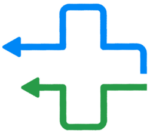Cervical and Lumbar Spinal Stenosis
Department of Cervical and Lumbar Spinal Stenosis
Spinal stenosis is the narrowing of one or more spaces within your spinal canal. Your spinal canal is the tunnel that runs through each of the vertebrae in your spine. It contains your spinal cord. Less space within your spinal canal cramps your spinal cord and the nerves that branch off it (nerve roots).
A tightened space can cause your spinal cord or nerves to become irritated, compressed or pinched. This can lead to back pain and other nerve issues, like sciatica. Several conditions and injuries can lead to a narrowed spinal canal.
Spinal stenosis can affect anyone, but it’s most common in people over the age of 50.
Types
1.Cervical Spinal Stenosis: Narrowing of the spinal canal in the neck region, potentially affecting the spinal cord and nerve roots.
2.Lumbar Spinal Stenosis: Narrowing of the spinal canal in the lower back, typically impacting nerve roots.
Diagnosis
1.Clinical Assessment: Evaluation of symptoms, including pain, weakness, or numbness in the neck (cervical) or lower back and legs (lumbar).
2.Imaging Studies: MRI or CT scans to visualize the spine and identify narrowing of the spinal canal.
Treatment
1.Conservative Management: Physical therapy, pain medications, and lifestyle modifications to manage symptoms.
2.Epidural Steroid Injections: Injections of anti-inflammatory medications into the spine to alleviate pain and inflammation.
3.Surgery (Decompressive Procedures): In severe cases, surgical procedures like laminectomy or laminoplasty to relieve pressure on the spinal cord or nerves.
Cervical and Lumbar Spinal Stenosis Overview
- Surgery Time - 8 hours
- Stay in the country - 3 days
- Rehabilitation - 30days
- Best price - 1800$
- Surgery Time - 8 hours
- Stay in the country - 3 days
- Rehabilitation - 30days
- Best price - 1800$
- Surgery Time - 8 hours
- Rehabilitation - 30days
- Best price - 1800$
- Best price - 1800$
- Surgery Time - 8 hours
- Stay in the country - 3 days
- Rehabilitation - 30days
- Best price - 1800$
- Surgery Time - 8 hours
- Rehabilitation - 30days
- Rehabilitation - 30days
- Best price - 1800$
- Surgery Time - 8 hours
- Stay in the country - 3 days
- Rehabilitation - 30days
- Rehabilitation - 30days
- Surgery Time - 8 hours
- Surgery Time - 8 hours
- Rehabilitation - 30days
- Best price - 1800$

